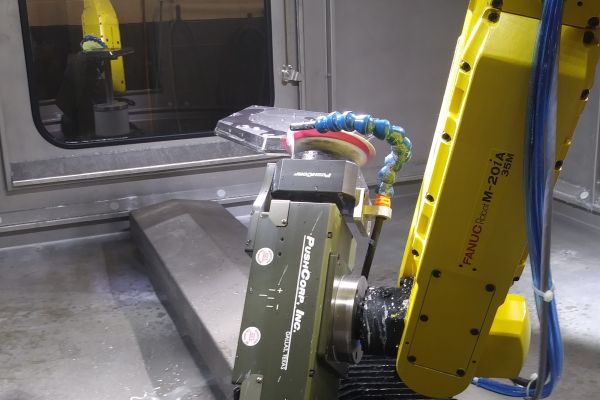 Mitchell Machine has extensive experience integrating robotics with custom machinery, providing automation solutions in a variety of customer applications.
Mitchell Machine has extensive experience integrating robotics with custom machinery, providing automation solutions in a variety of customer applications.
With the recent technological development of force limited collaborative robots (a.k.a. co-bots), engineers can now safely deploy industrial robots in new ways. For instance, safety-monitored stop, hand guiding, speed, and separation monitoring, and power and force limited methods all allow worker-robot collaboration to varying degrees.
This post covers four methods that fulfill the requirements of our customer’s most challenging applications.
Safety Monitored Stop
This method uses safety-rated sensing devices to detect when a human enters the robot’s work zone, with the robot controller quickly stopping the robot arm’s motion. Power to the robot is maintained and once the worker leaves the monitored area, the robot picks up where it left off. This method may save significant system downtime and almost all current, industrial robots can be used in this manner for a variety of applications.
Separation and Speed Monitoring
This is a relatively new application of robot and human collaboration in manufacturing. This method utilizes a standard industrial robot with optional safety software and equipment. The system requires sophisticated sensors or cameras to continually monitor an operator’s position. When a human is in a defined work zone shared with the robot, the robot may stop completely or reduce its speed and reach. When all zones are clear of operators, the robot can move at full speed and range of motion.
Hand Guiding
Typically, this method is used for teaching the robot paths for applications, such as dispensing, cutting, polishing or welding. It can also be employed in applications where the robot is being used by an operator as a lift assist. External devices, joysticks switches, and E-Stops are used by the operator as robot inputs. The operator visually guides a standard industrial robot arm at a safe, limited speed.
Limited Power and Force
This final method uses one of the newer “collaborative” robots. Because of the robot’s inherent capabilities, it is selected when physical contact between the human operator and the robot is beneficial to the process. All collaborative robots are not created equal. They have significantly different capabilities and programming methods. They also utilize different technologies to limit their speed and the force. Engineers designing end effectors and system components may utilize rounded corners or elastomeric padding to increase the surface area and lower the maximum contact force the robot can exert on a human being.
Mitchell Machine: Automated Robotics Systems
Our knowledge and experience with robotics systems help increase production consistency and process reliability which allows our customers to plan their production schedules to be more aggressive. Our highly experienced, dedicated robotic automation engineers design, manufacture and program turnkey robotic automation systems for a myriad of manufacturing applications including machine load/unload, part picking to assembly and inspection, material handling, part positioning, and multi-machine changeovers.
{{cta(‘e51f775f-ed91-47ca-92b9-5fb1d4c56aba’)}}






